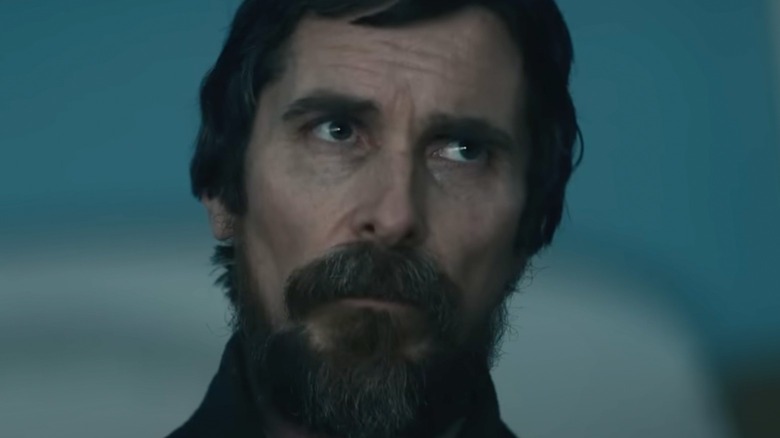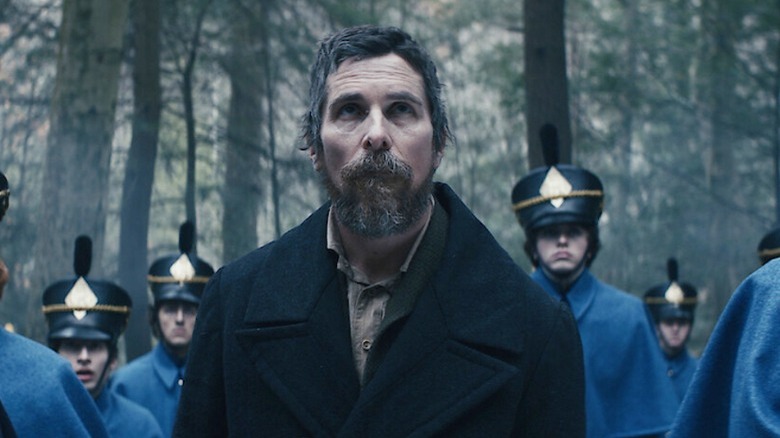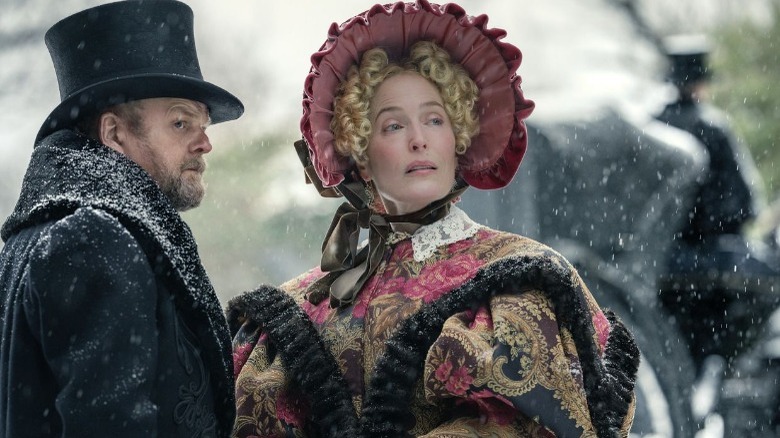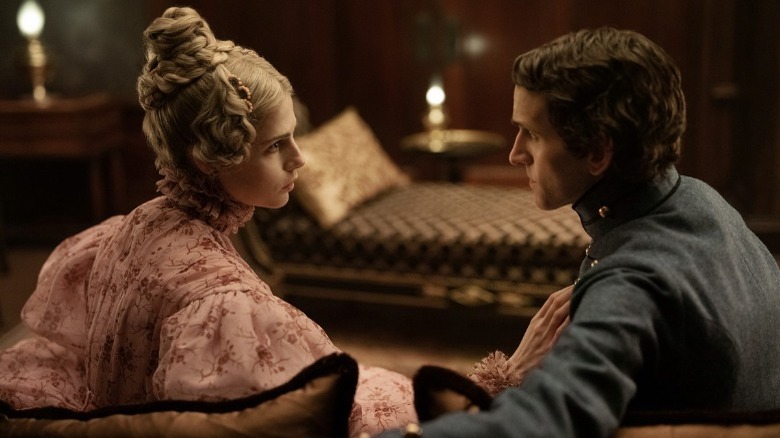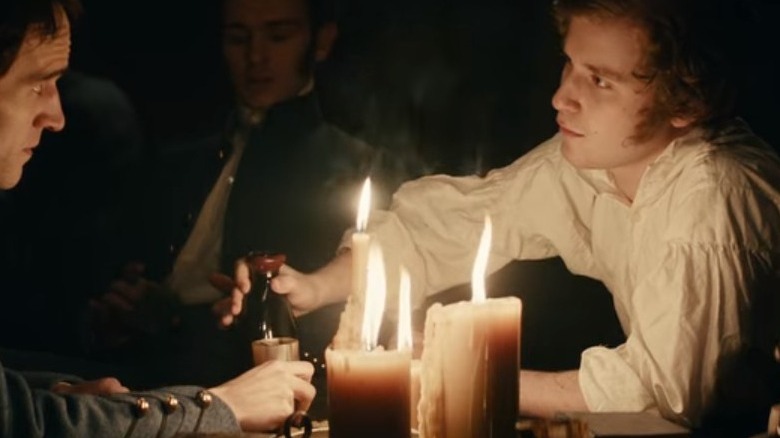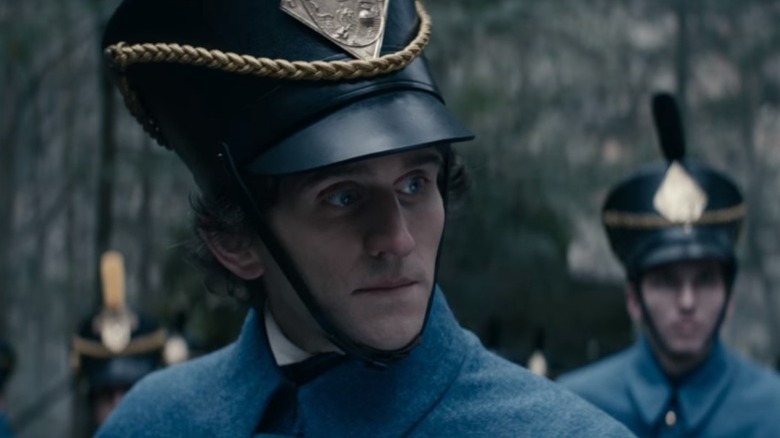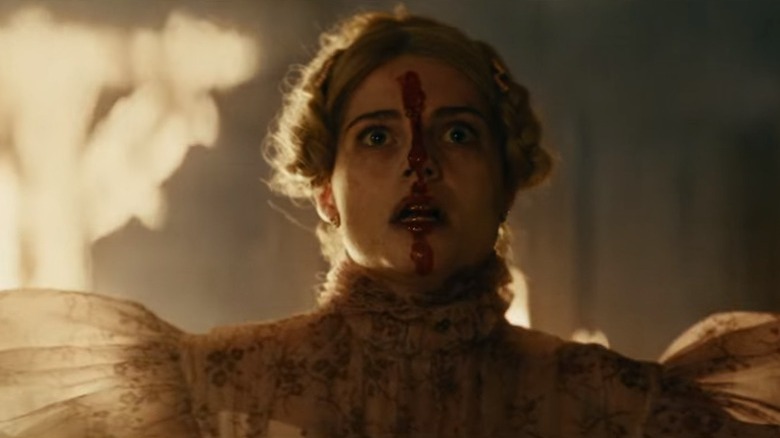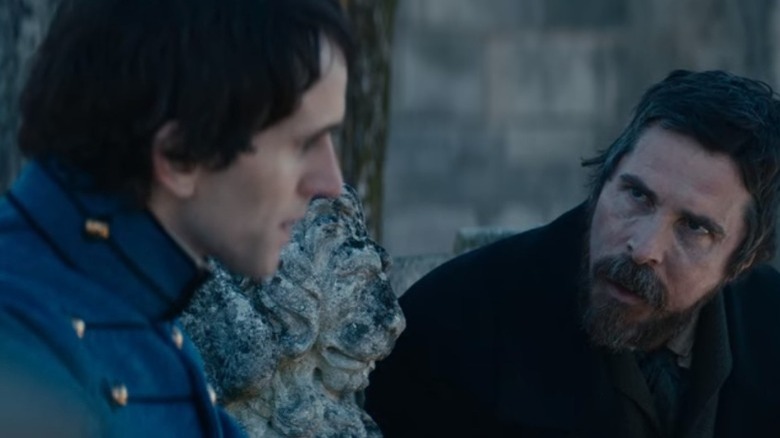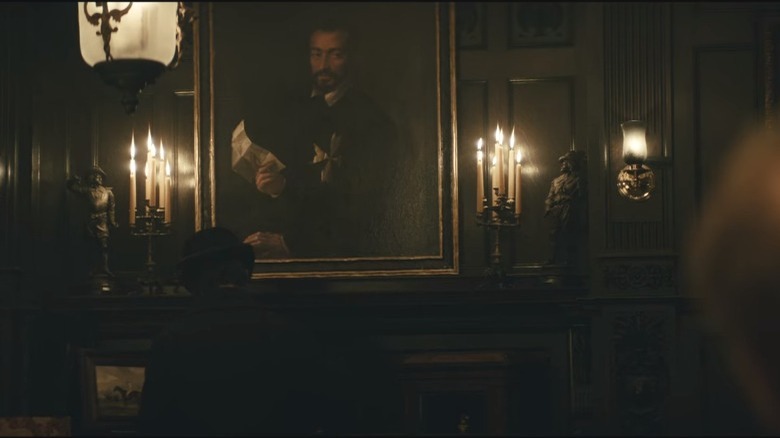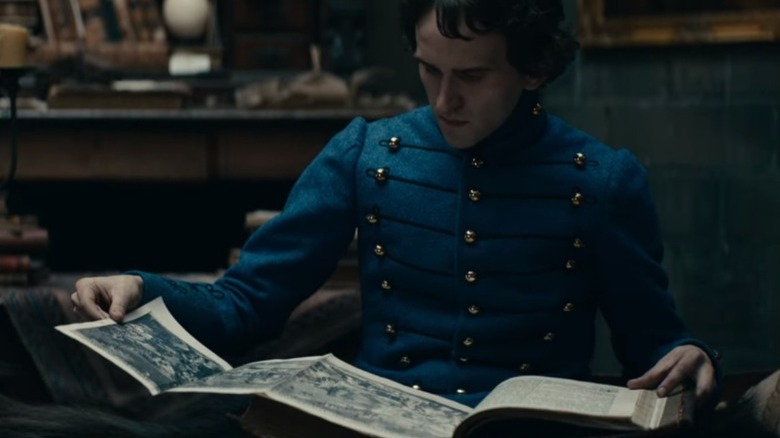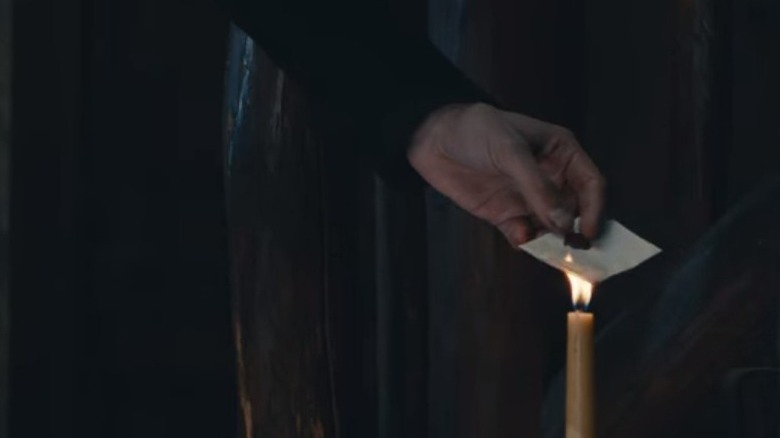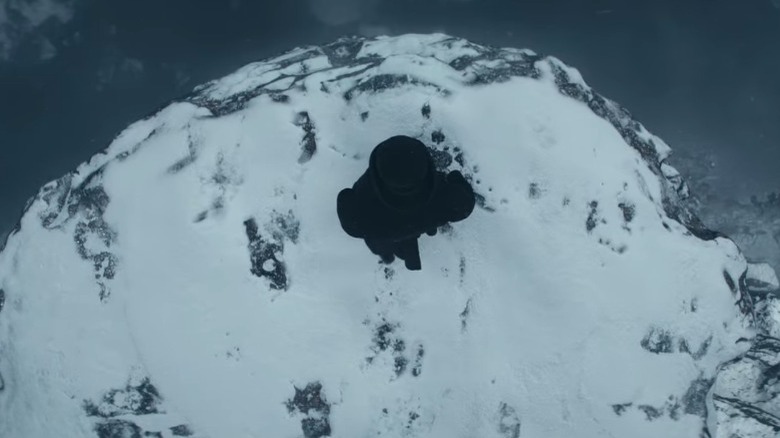The Ending Of The Pale Blue Eye Explained
Just in time for the gloomiest part of winter, Netflix's "The Pale Blue Eye" has arrived to explore the beginnings of detective fiction. Based on Louis Bayard's novel, the movie is a sort of origin story for the great American author and poet Edgar Allan Poe. Harry Melling (who you may recognize from "The Queen's Gambit") plays Poe during his brief tenure at West Point Military Academy, where he helps retired detective Augustus Landor (Christian Bale) solve the murder of a fellow cadet. Like much of Poe's work, the story involves visions of the dead, sickly pale women as muses, and even a tell-tale (missing) heart or two.
To be clear, Bayard's novel and the movie are both entirely fictional, but Melling's portrayal of the character is in the spirit of Poe's legacy, so "The Pale Blue Eye" is somewhere between "Lincoln" and "Abraham Lincoln: Vampire Hunter" in terms of accuracy. Moody, gloomy, and chillier than the Hudson river in wintertime, it's a clever procedural that builds to a stunning and emotional twist. If you're left confused, as if a raven woke you from a nap by rapping on your chamber door, let's break down "The Pale Blue Eye" and get straight what we saw and what we dreamed. This is the ending of "The Pale Blue Eye," explained.
The real killer
The big twist in "The Pale Blue Eye," which Poe helpfully spells out for us in a monologue in the style the detective the real Poe would go on to inspire, is that Landor is the killer of both cadets Fry (Steven Maier) and Ballinger (Fred Hechinger). Fry, Ballinger, and a third cadet named Stoddard (Joey Brooks) sexually assaulted Landor's daughter Mattie (Hadley Robinson) years before the events of the movie. Mattie managed to grab Fry's dog tag, which lead Landor to eventually lure him to the woods with a note and strangle him.
Fry's diary, in turn, gave Landor the identity of the other two attackers. After he killed Ballinger, Stoddard ran away, fearing for his life. After piecing together scattered information about how Mattie had "run off" from the townsfolk, Poe realizes Landor's true identity as the killer when he compares a note that Landor left for him with the scrap of paper found in the dead Fry's hand. "The Pale Blue Eye" turns on an enormous coincidence, in that Landor would be called to investigate Fry's murder, mere hours after committing himself, but as many characters note, his legend as a crime-solver precedes him.
If you or anyone you know has been a victim of sexual assault, help is available. Visit the Rape, Abuse & Incest National Network website or contact RAINN's National Helpline at 1-800-656-HOPE (4673).
The Marquis family
Landor is able to get away with murder in large part because of the actions of the Marquis family, perhaps the most Gothic American family not named Addams. Daughter Lea (Lucy Boynton) suffers from a "falling disease" (epilepsy, in modern-day terms), and her father Dr. Marquis (Toby Jones) has exhausted all of 1830's modern medicine in attempting to treat it. Apparently, with the full blessing and participation of creepy brother Artemus (Harry Lawtey) and excitable mother Julia (a criminally underutilized Gillian Anderson), the family has turned to occult magic to treat Lea's symptoms.
As Landor and Poe learn in a book of arcane information about witches, that means that they coincidentally require "the heart of a hanged man." So the night Fry is killed, Artemus uses his uncle's old officer's coat to dismiss the cadet guarding the body and remove its heart, throwing everyone entirely off Landor's scent. Landor later uses this as cover, removing Ballinger's heart as well as the hearts of local livestock to play into the perception that there's a "madman" on the loose.
Lenore and the pale blue eye
One of the chief pleasures of "The Pale Blue Eye" is the way it exists as a sort of fun pastiche of what we know will be recurring themes in the real Edgar Allan Poe's work — you could think of the movie as an imagined prequel or "superhero" origin story for Poe as the legend we're familiar with. His brief and doomed romance with Lea inspires him to recite a poem, a fictional one from author Louis Bayard, but one that references both "Lenore" and the "pale blue eye" that gives the story its title.
"Lenore" would become the name often used by Poe in his future poetry, usually the narrator of a poem would be mentioning a doomed, lost love. Over the course of his life, Poe lost his birth mother, adoptive mother, and wife to premature deaths, so Lea fits right into a pattern of pale, sickly muses for Poe's macabre work. It's no wonder that its love at first sight. The phrase "pale blue eye" appears in Poe's short story "The Tell-Tale Heart," in reference to the murder victim whose heart drives the narrator mad from beneath the floorboards, so ascribing it to Lea in "The Pale Blue Eye" foreshadows her own premature death (and grisly association with excised hearts).
Ballinger and Fry's diary
Not long after Ballinger attacks Poe in the woods for his interest in Lea, Ballinger is found hanged and mutilated the next morning. This casts suspicion on Poe for a minute, as he was understandably angry at Ballinger, but it's yet another red herring as it is of course Landor that killed the arrogant and aggressive cadet. What's entirely inexplicable is the fact that Ballinger didn't destroy Fry's diary, which implicated him in the attack on Mattie. By sending it to Fry's mother instead of just burning it, Ballinger accidentally marked himself for a brutal death.
We don't get to know Ballinger particularly well, so we don't know what motivates him to send the diary to Fry's mother, along with a note that implies she may well see fit to just burn it. There's no way, obviously, he could have known that she would instead innocently hand it over to the very man that killed her son, who would come after him next, but it's extremely unwise to leave it out there in general. In a broad sense, "The Pale Blue Eye" doesn't constitute an endorsement of West Point Academy — its cadets are mostly jocks and bullies that stumble blindly into their own deaths.
Why does Landor enlist Poe's help?
Although "The Pale Blue Eye" has been modestly successful with critics, the performances of Christian Bale and Harry Melling have been overlooked this awards season, which is a shame. In a dense screenplay that doesn't reveal much of either character's inner life, the bond between the retired detective and the odd young cadet is given depth and warmth by the two actors, and it really hits when Poe ultimately realizes he's just been used by Landor to help essentially frame the Marquis family for his own misdeeds. It's a shocking betrayal indeed, but it's still not entirely clear why Landor enlisted Poe's assistance to begin with.
When he learns that Fry's heart has gone missing, Landor perhaps intuitively realized that the organ thieves might provide him the exact cover he would need to kill his daughter's other attackers. He then recruited the bright young poet Poe hoping that he was clever enough to solve that mystery, but not so clever that he would put the entire scope of the situation together. And it nearly worked, but in letting his guard down about Mattie he revealed too much to his new protégé.
The ice house and the fire
Though it stops short of the truly unsettling horror of modern scary movie classics like "Midsommar," "The Pale Blue Eye" maintains an unsettling aura of mystery by never quite revealing exactly what the Marquis family does with stolen hearts. It's just some sort of unspecified occult ritual that involves a "magic circle" and leaves a fair amount of blood behind on the floor. Dr. Marquis believes that his daughter is communing with the spirits of the dead — epilepsy has historically been associated with seeing visions and hearing voices, and many contemporary psychiatrists believe Joan of Arc suffered from it — but he doesn't think that his children are capable of murder.
Luckily for Landor, they graduate to attempted murder at a convenient point in time and are on the verge of cutting out Poe's still-beating heart for the ritual when he discovers them in the ice house. Even more conveniently, both Lea and Artemus die in the ensuing fire when a candle gets knocked over, assuming the blame for the two murders Landor committed in the process as they're no longer alive to defend themselves. It's not clear how much knowledge their mother Julia had of the previous ritual with Fry's heart (or if she can confirm that her children didn't murder Fry), although she was apparently willing to be an observer for Poe's death.
Poe's history with Fry
It's inevitable that there comes a point in "The Pale Blue Eye" when it appears that Poe himself might be the murderer: That almost seems obligatory in a story where a legendarily death-obsessed figure like Poe is a prominent character. His poetry is dictated to him by his long-deceased mother, and the movie opens with a quote from the real Poe musing that "the boundaries which divide life from death are at best shadowy and vague. Who's to say where one ends, and where the other begins?"
But it's ultimately just a brief misdirect when we find out that Poe lied about having dealings with the deceased Fry in the past. Coming on the heels of Ballinger's murder after he and Poe fought, it seems like Poe might be settling personal vendettas. But Landor is skeptical, even when the West Point bosses insist on Poe's arrest, and takes Poe at his word when he sheepishly admits that Fry was just one of the plethora of fellow cadets that had bullied him for his awkward, bookish ways in the past year. If he killed every bully at West Point, the academy would be virtually empty.
Henri Le Clerc and immortality
It's not always a bad thing to commune with the dead in movies. Perhaps you can party with the dead, like in "Beetlejuice," or maybe your dead mother writes poetry for you, like Edgar Allan Poe in "The Pale Blue Eye." But much less benevolently, we learn that Lea Marquis had an inspiration for her occult-heart-ritual cure through a new friend that she "met": her great-great-grandfather Henri Le Clerc (who is not, in fact, based on any real-life person). In another of the story's astounding coincidences, the very same "misunderstood" devil-worshipping cleric and witch hunter Le Clerc that Landor's friend had mentioned turns out to be a direct ancestor of the Marquis family.
In retrospect, it's almost comical that Landor missed the giant portrait of Henri Le Clerc in the Marquis's house just days after seeing it in his friend Jean-Pepe (the brilliant Robert Duvall). Although it's mildly misleading that Le Clerc is also known to be a witch hunter, having put some 700 witches to death in his time. The other witch hunter and demonologist that Jean-Pepe mentions, Pierre de Lancre, did in fact exist and preside over mass witch trials in 17th-century France, but was reviled and infamous for practicing the "witches' sabbath," the exact sort of occult ritual that inspired the Marquises. Like the real Edgar Allan Poe's work, "The Pale Blue Eye" is fascinated by the thin line between religious piety and communing with death itself, with an emphasis on the macabre French tradition.
Down through the ages
Edgar Allan Poe is probably most famous for his poetry, made iconic for modern audiences thanks to the pitch-perfect interpretation of "The Raven" in a "Treehouse of Horror" installment of "The Simpsons." But he's also credited with essentially inventing the genre of detective fiction. Before Sherlock Holmes, Miss Marple, or Hercule Poirot, Poe's inspector C. August Dupin appeared in his 1841 short story "The Murders in the Rue Morgue" and established all the hallmarks of the detective story before the word "detective" was in regular use.
This knowledge adds a fun and touching subtext to "The Pale Blue Eye." At one point, while drinking together in the local tavern, Harry Melling's Poe is clearly excited to be working with the renowned inspector Landor and promises "I shall write a poem someday, sometime, that will send your name down through the ages." For the 20-year-old, a yet unsuccessful character, it's an ambitious promise, but from our perspective in the future (and reality), it's easy to trace the name "Augustus Landor" to "C. August Dupin," and imagine it as a tribute to an old friend. The movie's Poe seemingly goes on to immortalize Landor's deductive logic in prose, not quite poetry, and leaves out his murderous tendencies for good measure.
Poe's decision
After Poe's speech piecing the whole puzzle together, and Landor's weary confession, Poe asks "so what now?" Landor leaves the decision up to his new young friend, pointing out that he holds the only evidence that links him to the murders of Fry and Ballinger in the form of the notes that Landor left for Fry and Poe himself. Wordlessly, Poe burns the evidence and resolves to let Landor go free, causing the mourning and exhausted father to break into tears of anguished relief. As an orphan haunted by death himself, Poe perhaps knows that the acts of murder that Landor has committed will haunt him more than any kind of societal justice ever will.
It's a heavy, quietly devastating scene, as the act of mercy is overshadowed by the grim nature of what Landor has been through, as well as the sad fact of Poe departing his life for good. In another life, Landor speculates aloud, Mattie might have run into Poe the night of the ball instead of her assailants, and he'd have a happy daughter and future son-in-law instead of a life of death and sadness. Bale and Melling once again acquit themselves spectacularly well, weeping silent tears in turn as the melancholy becomes too much for them to bear.
Does Landor jump?
With the energy of a burdensome and weary sigh, "The Pale Blue Eye" draws to a close with Landor returning to the cliff's edge where Mattie leaped to her death. With his wife and daughter dead, and Mattie's attackers either dead or living a fearful life on the run, Landor has no purpose left and an uncertain future. Poe has spared him even the mixed solace of wasting away in prison, so it's natural to strongly suspect he's considering leaping from the cliff and joining his daughter in death.
Like the ending of "The Sopranos," it's impossible to know exactly what happens after the movie cuts to black, but it seems like "The Pale Blue Eye" errs on the side of hope. With a calm voice, Landor releases one of Mattie's ribbons into the wind and says "rest, my love." The events of the movie have left with him some semblance of closure — especially the decision not to pursue Stoddard, which signals acceptance on Landor's part more than it does despair. Perhaps influenced by Poe's unique views on the thin veil between life and death, he feels no need to hurry his own demise and join his family.
If you or anyone you know is having suicidal thoughts, please call the National Suicide Prevention Lifeline by dialing 988 or by calling 1-800-273-TALK (8255).
